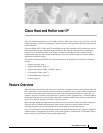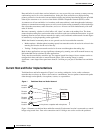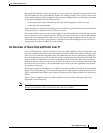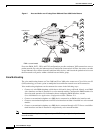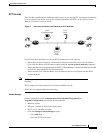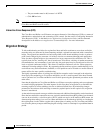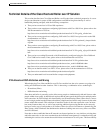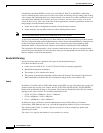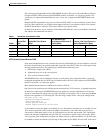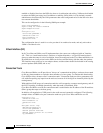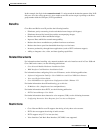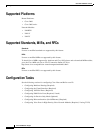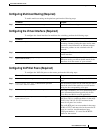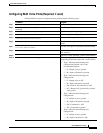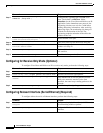
Cisco Hoot and Holler over IP
Feature Overview
7
Cisco IOS Release 12.1(5)T
Technical Details of the Cisco Hoot and Holler over IP Solution
This section describes how Cisco Hoot and Holler over IP works from a technical perspective. It covers
design considerations in terms of IOS configurations and DSP mixing functionality as well as
bandwidth planning and QoS, with the following assumptions:
1. That you have some level of Cisco IOS experience.
2. That you have some experience configuring QoS features with Cisco IOS. If not, please refer to the
IOS documentation on CCO at:
http://www.cisco.com/univercd/cc/td/doc/product/software/ios121/121cgcr/ip_c/index.htm
3. That you have some experience configuring VoIP with Cisco IOS. If not, please refer to the IOS
documentation on CCO at:
http://www.cisco.com/univercd/cc/td/doc/product/software/ios121/121cgcr/multi_c/mcprt1/mcdv
oip.htm
4. That you have some experience configuring IP multicasting with Cisco IOS. If not, please refer to
the documentation on CCO at:
http://www.cisco.com/univercd/cc/td/doc/product/software/ios121/121cgcr/ip_c/ipcprt3/1cdmulti.
htm
5. That you have a working IP network, with IP multicasting configured using the Cisco 2600 and
Cisco 3600 series routers. If not, please refer to the documentation on CCO at:
http://www.cisco.com/univercd/cc/td/doc/product/software/ios121/121cgcr/index.htm
http://www.cisco.com/univercd/cc/td/doc/product/access/acs_mod/cis2600/index.htm
http://www.cisco.com/univercd/cc/td/doc/product/access/acs_mod/cis3600/index.htm
6. That you are familiar with Cisco IP/TV. If not, please refer to the documentation on CCO at:
http://www.cisco.com/univercd/cc/td/doc/product/software/iptv30/
7. That you understand basic hoot and holler concepts and equipment.
IP Multicast and DSP Arbitration and Mixing
When deploying Cisco Hoot and Holler over IP, first consider how the voice streams are going to be
mixing and distributed to other locations. This is done using a combination of two technologies:
• IP multicast (IPmc)
• DSP arbitration and mixing
Since hoot and holler is generally used to allow many people to simultaneously talk and listen to other
people within a hoot group, by definition it requires that the same speech be delivered to multiple parties
at the same time. In an IP network, this functionality uses IP multicasting (IPmc). IPmc allows a source
to send a single packet into the IP network and have it duplicated and sent to many listeners by the other
routers within the network. This technique is beneficial in that it does not require the source to know
how many listeners there are, as well as not requiring additional processing burden on the source by
having to send a copy of each packet to all listeners. IPmc also allows for listeners to dynamically join
IPmc groups, which eliminates the administrative burden of adding new users every time a new IPmc
session is initiated.
Now that we have established that an IP network can forward packets in a way similar to existing hoot
and holler networks, we also must examine how the individual router/gateways can handle mixing and
arbitrating the various voice streams that could initiate or terminate on its voice ports. This functionality



